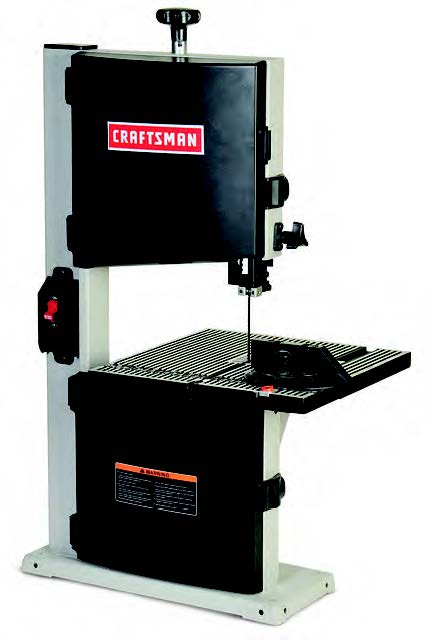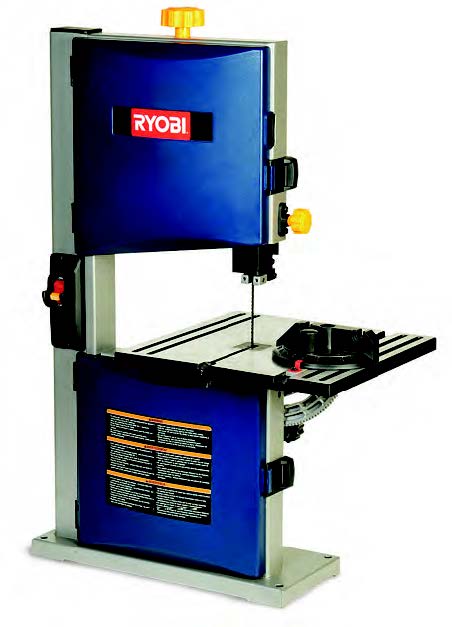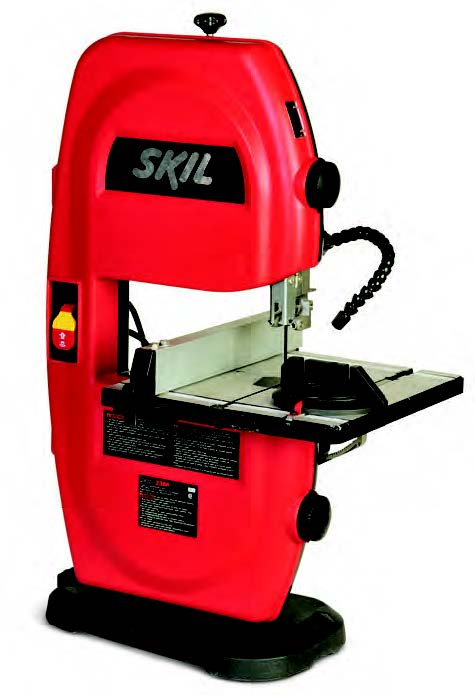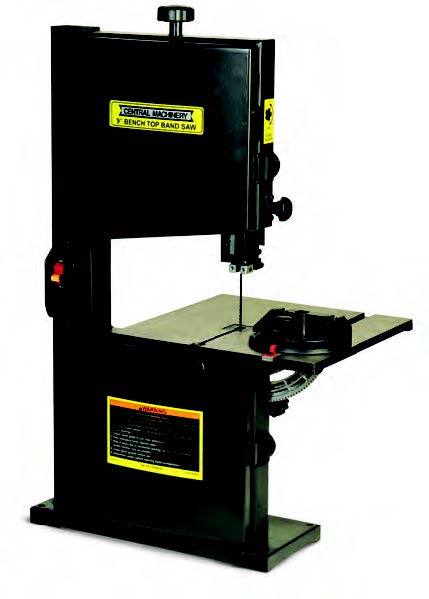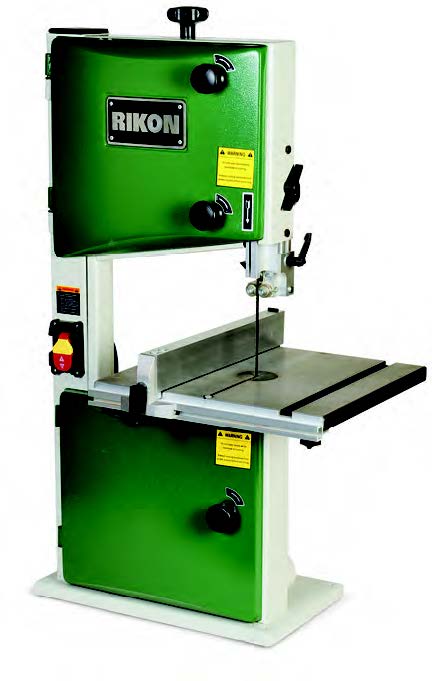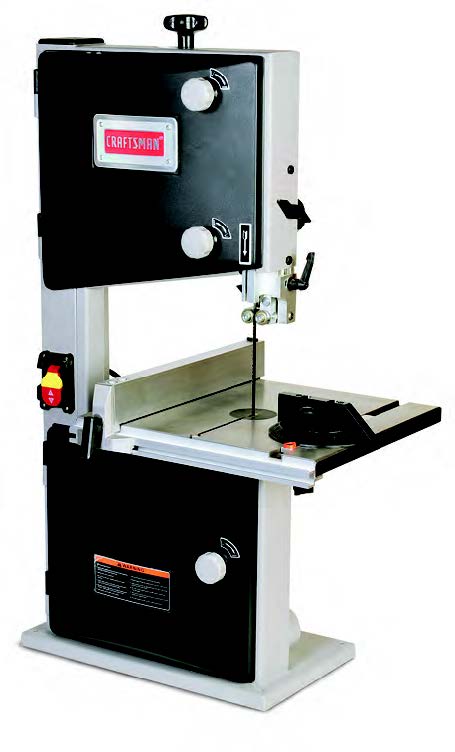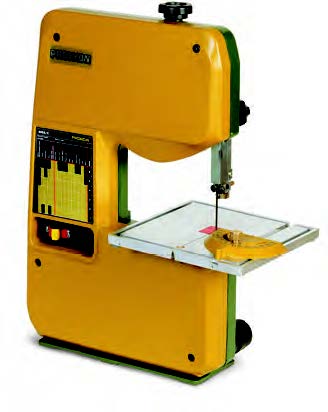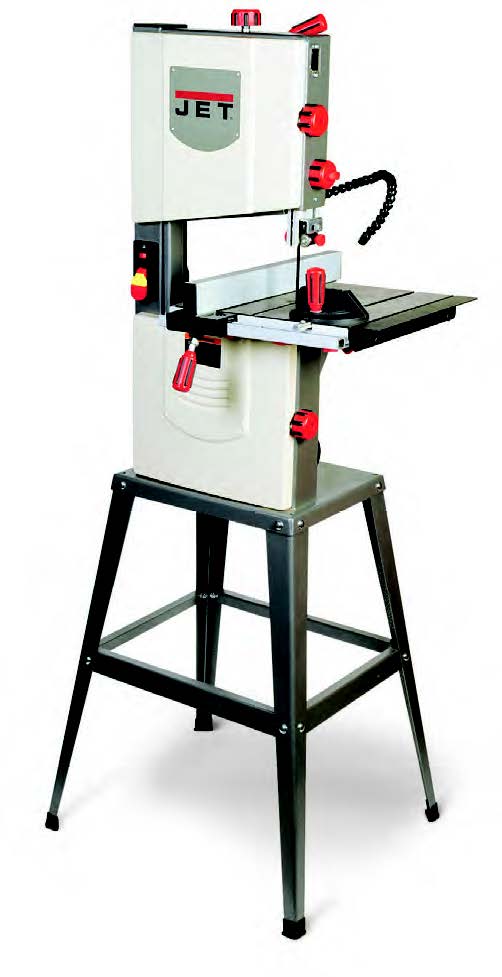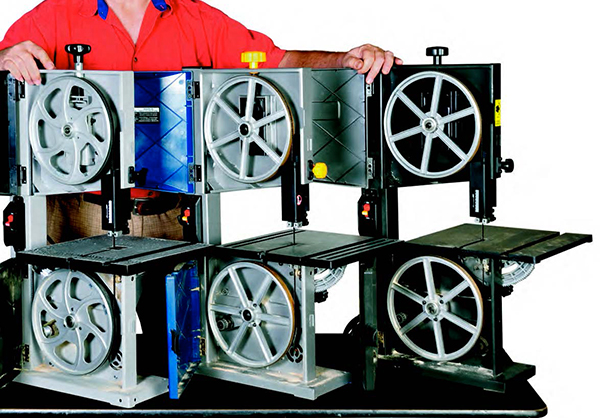
We test eight small band saws. Which one is best?
I’ve never thought much of the small “benchtop” sized band saws I’ve previously tried. The ones I’ve used in the past have proved to be more toy than tool, with poor blade tracking and barely enough power to chew through thin softwood stock. But recently, I noticed that several power tool companies were offering small band saws made with much the same construction and features found on full-sized saws. Intrigued, I set about to test as many of these little saws as I could. I managed to get my hands on eight different saws: four 9″ models by Craftsman, Central Machinery, Ryobi and Skil; three 10″ models by Craftsman, RIKON and JET; and, to round out the field, a 150mm “Micro” band saw made by English power tool manufacturer Proxxon.
My goal was twofold: First, to determine what kinds of woodworking jobs these diminutive, affordable band saws are capable of. Second, to pick the best of the bunch for this magazine’s “Best Bet” designation, awarded to the tool that demonstrates the best blend of features, performance and price. I examined each saw’s extensive features carefully, and probed its performance by doing a full range of cutting tests to find out how much each benchtop tool could handle.
A word before we begin: The great majority of power tools these days are made overseas by OEM (original equipment manufacturers) factories that build each model to the specifications of the company that’s going to put their name on them. This helps explain why three of the four 9″ benchtop band saws I tested — the Craftsman, Central Machinery and Ryobi — have virtually the same welded steel frame, base and overall design. But just because some saws may look similar doesn’t mean that they’re identical. Besides varying in features and cosmetics, each saw has its own performance personality, and some just flat-out cut better than others.
Craftsman BAS230 9-inch Band Saw Review
Street Price: $120
Actual Throat Depth / Max. Cutting Depth: 9″ / 3-5⁄8″
Construction:Welded steel frame and cast alloy table
Motor Type / Amperage / Blade Speed: Induction / 2.5 amp / 2460 fpm
Table Size: 11-3⁄4″ x 11-3⁄4″
Blade Length / Min.-Max. Widths: 62″ / 1/8″ – 3/8″
Blade Guides: Friction side guides and ball thrust bearing
Tension Release Lever / Light: Yes / No
Rack & Pinion Table Tilt / Upper Guide: No / Yes
Warranty: 1 year
Accessories Included / Optional: Miter gauge
Actual Weight: 34 lbs.
Of the two benchtop band saws that bear the Craftsman name, the 9″ BAS230 has a price on par with the other three 9″ saws in this test. There are but a few elements of the Craftsman that distinguish it from the competition. While its welded frame is just like two other saws, its wheels have wider, sturdier looking spokes than the other two. Plus, the Craftsman’s wheels have pressedon weights, evidence that the wheels have undergone balancing to help them run with less vibration. My cutting tests bore this out, and the BAS230 cut slightly more smoothly than any of the other 9″ saws.
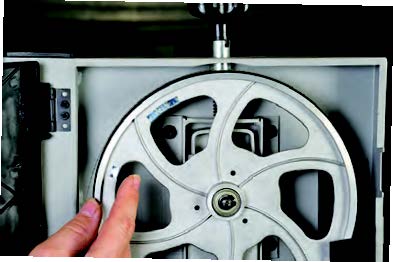
The Craftsman has plenty of power to tackle all the basic band saw cutting operations, crosscutting, ripping and even doing light resawing of hardwoods. The 3/8″ wide, 6 tpi blade that comes standard on the BAS230 gives a good quality of cut and leaves a relatively clean kerf. The saw’s large cast-alloy table offers good support to larger workpieces, and is the only table in the group with a fully ribbed surface. This is a practical feature, as the ribs can help keep sawdust from hanging up the workpiece.
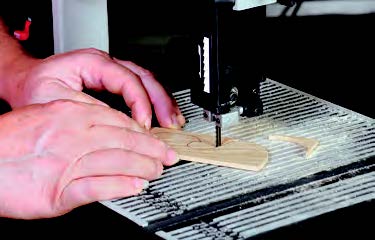
To stabilize its running blade, the Craftsman BAS230 is fitted with the exact same ball-bearing thrust bearings and steel pin friction side guides (both above and below the table) as found on the Central Machinery and Ryobi saws. Although many woodworkers feel that ball bearing side guides are better, to tell you the truth, I didn’t really miss them on these small saws. Friction pins are easy to adjust and do a fine job of stabilizing the blade during cutting. Unfortunately, the upper guides on the Craftsman mount to the same molded plastic guide post assembly found on the other two saws. These posts raise and lower smoothly, via a rack-and-pinion mechanism. But the posts also deflect relatively easily and could possibly break if impacted by a sharp blow.
Ryobi BS903 9-inch Band Saw Review
Street Price: $120
Actual Throat Depth / Max. Cutting Depth: 9″ / 3-5⁄8″
Construction:Welded steel frame and cast alloy table
Motor Type / Amperage / Blade Speed: Induction / 2.5 amp / 2500 fpm
Table Size: 11-3⁄4″ x 11-3⁄4″
Blade Length / Min.-Max. Widths: 62″ / 1/8″ – 3/8″
Blade Guides: Friction side guides and ball thrust bearing
Tension Release Lever / Light: Yes / No
Rack & Pinion Table Tilt / Upper Guide: Yes / Yes
Warranty: 3 years
Accessories Included / Optional: Miter gauge
Actual Weight: 37 lbs.
The bright blue and yellow Ryobi BS903 band saw is sold exclusively through the Home Depot chain of building supply stores, and comes with a very generous three-year warranty. Like the similarly appointed Craftsman and Central Machinery models, the Ryobi sports a blade tension release lever, something more typically found on full-sized band saws. It’s a nice feature because routinely loosening tension can prevent a blade from taking a “set” on its wheels, thus helping it to run more smoothly over its lifetime. The BS903 has a small, clear plastic-covered window on the upper wheel guard (also on the 9″ Craftsman, Skil, and JET). The window makes it easier to safely adjust the tracking so that the blade rides on the center of the wheel’s rim.
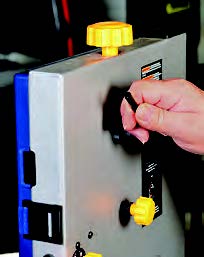
Performance-wise, I honestly had trouble distinguishing the Ryobi’s cutting abilities from its similarly built competitors. This isn’t too surprising, considering the similarity of the blade guides and post, and the fact that all four 9″ saws are powered by a 2.5-amp induction motor that drives the lower wheel via a short belt. The BS903 crosscut well using exactly the same little plastic-headed, aluminum bar miter guide as comes with the Craftsman and Central Machinery saws. The gauge is basic, but adequate for the small cuts you’re likely to perform with these small band saws. Even though the Ryobi and two similar competitors don’t come with rip fences, I used a clamped board to test their rip and resaw abilities, which were adequate for the scope of work these saws are meant to handle. You can resaw hardwoods as wide as the saw’s 3-5⁄8″ cutting depth capacity. Just be patient, as the feed speed must be slow to prevent bogging down the blade.
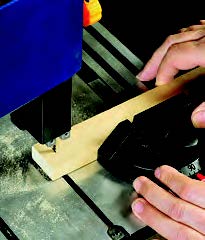
Dust collection ports, located at the bottom of the lower wheel housing, are built into all of the saws in this test. The Ryobi’s is a slightly larger size than found on the other 9″ saws, allowing you to connect a standard 2-1⁄2″ hose. Hooked up to a powerful shop vacuum, the Ryobi had very good sawdust capture.
Skil 3386 9-inch Band Saw Review
Street Price: $129
Actual Throat Depth / Max. Cutting Depth: 9″ / 3-5⁄8″
Construction:Cast alloy frame and table
Motor Type / Amperage / Blade Speed: Induction / 2.5 amp / 2800 fpm
Table Size: 11-3⁄4″ x 12″
Blade Length / Min.-Max. Widths: 59-1/2″ / 1/8″ – 3/8″
Blade Guides: Friction side guides and ball thrust bearing
Tension Release Lever / Light: No / Yes
Rack & Pinion Table Tilt / Upper Guide: Yes / Yes
Warranty: 1 year
Accessories Included / Optional: Miter gauge and rip fence
Actual Weight: 30 lbs.
With its cast frame and curvy design, the Skil 3386 is a standout in this group. It offers a nice blend of features and performance in an attractive package. The Skil’s alloy frame and table help keep this saw lighter than any of the other 9″ saws: a good thing if you’re serious about avoiding back strain when lifting it. To help keep the saw in place during use, the frame is mounted to a base made from heavier cast iron.
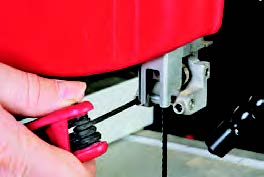
The Skil’s overall build quality seems good, and the saw features a guide post made of cast alloy that feels very solid. It adjusts up and down via a concentric pair of knobs, much like the JET. But I found the Skil’s controls a bit easier to use. The 3386 uses steel friction-pin side blade guides, like the other 9″ saws, but the Skil’s guides are larger in diameter: 3mm, as opposed to 2mm, with larger set screws holding them in place. The 3386 lacks a blade tension release lever, but you can always loosen the blade tension knob at the end of your work session.
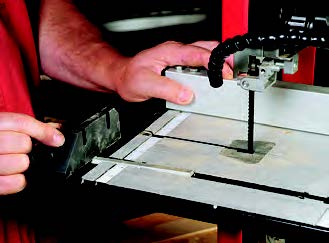
Much like the Central Machinery and Ryobi saws, the 3386’s table tilts for beveled cuts via a geared trunnion. The Skil uses concentric knobs that are easy to set, and its angle scale is a bit easier to read than the other two saws. It’s the only 9″ saw that comes with a rip fence — a nice addition. Like the fences on the 10″ saws, the Skil’s locking lever secures the fence at both ends of the table. Plus, the Skil’s table has scales inlaid at both ends, allowing you to check the parallelism of the fence before locking it. I had an issue with the saw’s miter gauge, which has a bar that’s T-shaped in profile, designed to keep the bar from lifting out of the table slot. Unfortunately, the Skil’s table slot only has two sets of tabs to keep the bar in place. In use, the bar sometimes caught on these tabs, stalling the cut.
Despite this shortcoming, the Skil performed very well in all my cutting tests, and could even resaw an oak strip as wide as its maximum cutting depth (3-5⁄8″) without stalling. It ran reasonably smoothly and the blade tracked very well. One feature I really appreciated was the saw’s gooseneck mounted LED light.
Central Machinery 96980 9-inch Band Saw Review
Street Price: $120
Actual Throat Depth / Max. Cutting Depth: 9″ / 3-5⁄8″
Construction:Welded steel frame and cast alloy table
Motor Type / Amperage / Blade Speed: Induction / 2.5 amp / 2460 fpm
Table Size: 11-3⁄4″ x 11-3⁄4″
Blade Length / Min.-Max. Widths: 62″ / 1/8″ – 1/2″
Blade Guides: Friction side guides and ball thrust bearing
Tension Release Lever / Light: Yes / No
Rack & Pinion Table Tilt / Upper Guide: Yes / Yes
Warranty: 90 days
Accessories Included / Optional: Miter gauge
Actual Weight: 44 lbs.
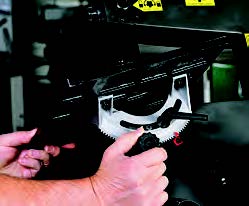
Central Machinery is the Harbor Freight company’s house brand, sold through its stores, catalogs and Internet sales. If you like cast-iron machines, you’ll like the 96980. Its table is the same size as found on other 9″ saws, but it is a smooth-surfaced piece of cast iron. This does add substantially to the weight of the saw: it’s 14 pounds heavier than the lightest 9″ saw, the Skil. The table attaches to the frame via a nice geared trunnion assembly; the Ryobi and Skil saws have a similar setup. To change the table’s tilt angle, simply loosen the table-locking handscrew and rotate a knob to dial in the desired angle. There’s also an adjustable stop for quickly setting the table square to the blade — the position it’s bound to stay in most of the time. One quibble I have with this table is its location: It extends only 4-1⁄2″ ahead of the blade, whereas the other saws offer 5-1⁄4″ of support. This doesn’t seem like much, but I did notice the reduction of support, especially when I cut longer workpieces.
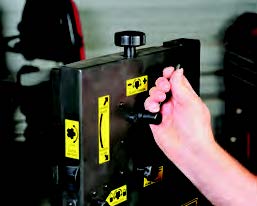
Switched on, the Central Machinery band saw has good overall power and runs smoothly, with an acceptable quality of cut. A small thing I appreciated was the Central Machinery’s clear labeling of all controls: blade tension and tracking, guide post raising/lowering and lock controls, etc. Despite the saw’s good features and performance, one reservation I’d have in choosing this over the other models is that it only carries a 90-day warranty, not much compared to the one- to five-year warranties that come with the other benchtop band saws.
RIKON 10-305 10-inch Band Saw Review
Street Price: $265
Actual Throat Depth / Max. Cutting Depth: 9-5⁄8″ / 4-5⁄8″
Construction:Welded steel frame and cast iron table
Motor Type / Amperage / Blade Speed: Induction / 3.5 amp / 2780 fpm
Table Size: 13-3⁄4″ x 12-1⁄2″
Blade Length / Min.-Max. Widths: 70-1/2″ / 1/8″ – 1/2″
Blade Guides: Ball bearing upper and lower
Tension Release Lever / Light: No / No
Rack & Pinion Table Tilt / Upper Guide: No / Yes
Warranty: 5 years
Accessories Included / Optional: Rip fense, miter gauge, metal stand
Actual Weight: 64 lbs.
Just about every description you could give of the Craftsman 21400 is true for the RIKON 10-305. Aside from different colored paint and name plaques, the two saws are virtually identical, including all their adjustment knobs. But, despite appearances, there are a few significant differences. The first noteworthy difference is that the RIKON sells for about $65 more than the Craftsman. The only thing I could figure was worth the extra cost is the RIKON’s whopping five year warranty — the longest in this group of benchtop band saws. In contrast, the Craftsman’s warranty is one year long; the JET, three.
Performance-wise, the RIKON proved to be significantly less powerful than its competition. During my cutting trials, the 10-305 handled all the usual crosscuts and curved cuts on 4/4 stock without noticeably straining.
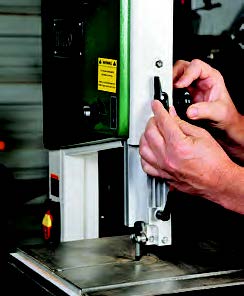
But when I resawed the same piece of 4-5⁄8″-wide red oak I had cut with the 21400, the RIKON slowed to the point of stalling. I could nurse the cut along, but could only feed the work at a snail’s pace. I checked the blade tension, as well as the tightness of the drive belt, and even swapped blades with the Craftsman, just to make sure that the blade wasn’t at fault; nothing seemed to improve the tool’s resawing performance.
One more small ding: Although the 10-305 has a trunnion assembly that’s virtually the same as used on the other three 10″ saws, its locking handle is much smaller. It’s simply a pain to tighten and loosen when adjusting the tilt of the table.
Craftsman 21400 10-inch Band Saw Review
Street Price: $200
Actual Throat Depth / Max. Cutting Depth: 9-5/8″ / 4-5⁄8
Construction:Welded steel frame and cast iron table
Motor Type / Amperage / Blade Speed: Induction / 3.5 amp / 2780 fpm
Table Size: 13-3⁄4″ x 12-1⁄2″
Blade Length / Min.-Max. Widths: 70-1/2″ / 1/8″ – 1/2″
Blade Guides: Ball bearing upper and lower
Tension Release Lever / Light: No / No
Rack & Pinion Table Tilt / Upper Guide: No / Yes
Warranty: 1 year
Accessories Included / Optional: Miter gauge, rip fence
Actual Weight: 65 lbs.
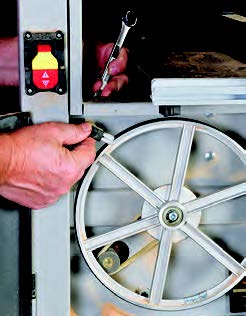
What does the Craftsman 21400 share with the other two 10″ saws in this test? All three have similar welded sheet metal frames, cast-iron tables and cast-alloy wheels. The 21400’s wheels are balanced, for smoother running, and an adjustable brush on the lower wheel wipes sawdust from the spinning tire, to help keep the blade tracking smoothly. The three saws lack the nice geared trunnion assemblies featured on the 9″ saws, but they do sport nice extruded aluminum upper guide posts. The posts are very solid, and they adjust up and down smoothly via a rack-and-pinion mechanism. The saws also feature full ball-bearing thrust and side guides both top and bottom. The guides on the Craftsman adjust with an Allen wrench and are easy to fine tune for smooth operation (ditto the RIKON).
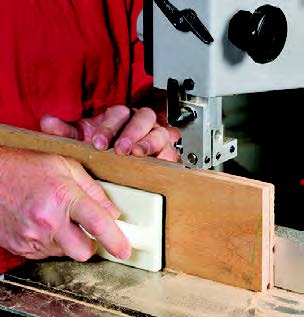
Power-wise, the Craftsman is fitted with a 3.5-amp induction motor. In terms of cutting performance, that 1-amp upgrade (compared to the 9″ saws) seemed to make quite a difference. The 21400 had plenty of power to take thick cuts in hardwoods, and even resaw boards as wide as its 4-5⁄8″ cutting depth. The guides help stabilize the blade very effectively, resulting in kerfs that are straight and true. Even though the Craftsman’s blade is the same kind of hook-toothed 6 tpi general purpose blade found on all saws in this test (save the Proxxon), the smoothness of cut suffered considerably with the 21400. Whether crosscutting or ripping, all three 10″ saws left more ragged kerfs than produced by their 9″ cousins.
Proxxon MBS/E Band Saw Review
Street Price: $260
Actual Throat Depth / Max. Cutting Depth: 5-7/8″ / 3-13⁄32″
Construction:Cast alloy frame and table
Motor Type / Amperage / Blade Speed: Permanent magnet DC Motor / .7 amps / 395-820 fpm*
Table Size: 7-7⁄8″ x 7-7⁄8″
Blade Length / Min.-Max. Widths: 42″ / 9/64″ – 13/64″
Blade Guides: Ball bearing upper and slotted post lower
Tension Release Lever / Light: No / No
Rack & Pinion Table Tilt / Upper Guide: No / No
Warranty: Two years
Accessories Included / Optional: Miter gauge/Coolant system*
Actual Weight: 13 lbs.
*Electronic variable speed control.
**For cutting ceramics, stone and glass.
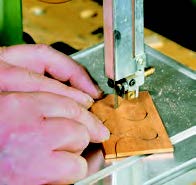
The Proxxon Micro Saw is by far the smallest, lightest, most easily portable and stowable saw in this bunch. It has only 5-7⁄8″ of throat depth and about 3-3⁄8″ of cutting depth. It’s also the only saw with a permanent magnet DC motor (the same kind used on most portable power tools) that’s only rated at 85 watts — about .7 amps. By including a variable-speed motor and offering a wide assortment of blade types, the MBS/E can handle wood, plastic, metal and, fitted with the optional water cooling kit, ceramic tile and even stone and glass! The Proxxon’s construction is quite good, with a rigid cast-alloy frame and a polished aluminum table. One small pain is that you have to undo four Allenhead screws each time you want to remove the Proxxon’s one-piece wheel guard, making blade changes a bit tedious.
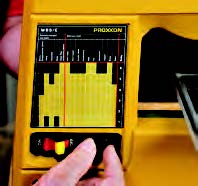
When I ran the MBS/E through its cutting paces, I was generally impressed with the precision of its performance. Both the cross and rip cuts I tried with the saw were clean and square, thanks in part to the saw’s smooth-running wheels and tiny ball bearing guides. Fitted with the optional 24-tooth, 13/64″-wide blade, the saw cut on a dime and left an extremely clean kerf.
JET JWBS-10OS 10-inch Band Saw Review
Street Price: $370
Actual Throat Depth / Max. Cutting Depth: 9-5/8″ / 4-1⁄8″
Construction:Welded steel frame and cast iron table
Motor Type / Amperage / Blade Speed: Induction / 3.4 amp / 2750 fpm
Table Size: 13-3⁄8″ x 13-1⁄8″
Blade Length / Min.-Max. Widths: 67-1/2″ / 1/8″ – 1/2″
Blade Guides: Ball bearing upper and lower*
Tension Release Lever / Light: Yes / Yes
Rack & Pinion Table Tilt / Upper Guide: No / Yes
Warranty: 3 years
Accessories Included / Optional: Miter gauge, rip fence, metal stand
Actual Weight: 73 lbs. with stand
*Tool-less adjustment of the upper guides
The JET is by far the most extensively equipped band saw in this group, with more bells and whistles than any other model, including its own pressed-sheet-metal stand (you can remove the stand to use it as a benchtop tool). The JWBS-10OS frame is very similar to the Craftsman and RIKON, but it is set up to take a slightly shorter blade. The saw’s resaw capacity is also slightly less: 4-1⁄8″ versus 4-5⁄8″. The JET’s cast-iron table is much like the other saws, but it includes a pull-out support attached below its outboard edge: really nice if you’re sawing a large panel or crosscutting longer stock.
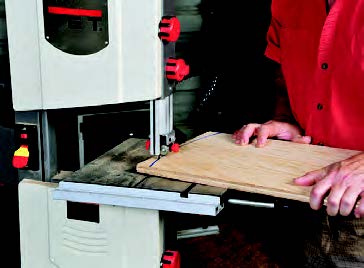
The JET’s ball bearing blade guide assemblies are like those found on the other 10″ models, but the upper guides on the JET allow tool-less adjustments. Loosening the plastic-knobbed handscrews used to lock these adjustments allows you to rotate each eccentrically mounted bearing: Turning it brings the bearing either closer to or farther from the blade. Very convenient. In contrast, I didn’t care for the JET’s controls for adjusting the height of the upper guide post. Most other saws have separate knobs for raising/lowering and locking the post. A pair of concentric knobs does the same job on the JET, but the outer raising/lowering ring often shifted as I tightened the locking knob at its center.
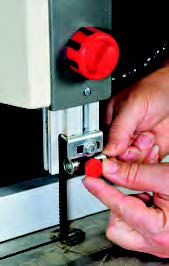
Performance-wise, the JET JWBS-10OS runs very well and cuts with good power. How good? I did a little cutting test with the JET, Craftsman and Rikon, resawing a 4-1⁄8″-wide (the JET’s max cutting capacity) red oak board and timed how long it took each saw to get through the cut, pushing as hard as I could without slowing blade speed significantly. The JET could cut at a pace of a foot every 44 seconds, while the Craftsman took 68 seconds and the Rikon a glacially paced 138 seconds per foot. Further inspiring confidence in its cutting abilities, the JET’s 3.4-amp motor sports an aluminum housing and heat-dissipating fins, to help keep things cool during longer cutting sessions.
A few other features on the JWBS-10OS are worth mentioning: It was the only saw that had a built-in blade tension scale that clearly showed how tight to set the tension knob for any blade that would fit the saw, from 1/8″ to 1/2″ wide. Even though blade tension doesn’t seem to be particularly critical with any of these small band saws, it’s very handy to have a way to gauge the actual tension of a blade and set it to the manufacturer’s specified tightness. Surprisingly, the JET is also the only 10″ band saw to have a blade tension release lever.
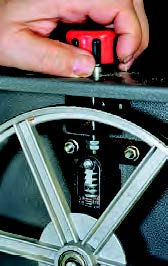
The JET’s rip fence is nicer than on any other band saw in this test, with a large locking lever and a cursor window that makes it easy to set precisely for rip cuts and resawing chores. Like the Skil, there’s a gooseneck LED light, but the JET’s has a separate On/Off switch which allows you to see what you’re doing before starting up the saw. Like all the other band saws in this article, the JET has a built-in dust port in the lower wheel housing. The JET’s port offers the most flexibility, with a concentric port that accepts 4″-, 2-1⁄2″- and 2″-dia. hoses.
Benchtop Band Saw Reviews Conclusions – The Best Bet
I’ve done a few dozen tool tests in my time, but few have left me with more head scratching than this one. On the one hand, you have two groups of similar saws; four 9″ saws and three 10″ saws, and a “Micro” band saw that’s different than anything else. Which to choose?
Ultimately, the benchtop band saw that’s best for you depends greatly on what your real needs are: If you’re a puzzle maker, model builder or hobbyist that often tackles small-scale projects, I have little doubt that the Proxxon will serve you well. If you often tackle full-size projects, but don’t have the space or budget for a full-sized band saw, then the decisions get a bit trickier. The JET has lots of features and is powerful and user-friendly. But its stand-mounted size and relatively high price put it in league with larger, more versatile band saws in the 14″ range. The Craftsman’s low price tag and good performance make it a bargain, but at 65 lbs., it’s not exactly a portable, easily stowable saw. Plus, consider this: None of the 10″ models actually has a 10-inch-deep throat: All three saws have 95⁄8″ of throat depth. That really levels the playing field between 9″ and 10″ models, as the “larger” models only between 9″ and 10″ models, as the “larger” models only offer a slight amount of additional cutting width and an inch or so of depth capacity.
Considering all this, I think the best benchtop band saw for the average small shop woodworker should be compact and portable, capable of decent cutting performance and offer good value for the money. The Skil 3386 has all these qualities, and hence, it gets my vote as the “Best Bet” among these options for a benchtop band saw. The Skil is smaller and, thanks to its alloy frame, lighter and more easily portable than any other saws in this test, save the petite Proxxon. It has nice, solid guides, cuts with good power and lacks only a small amount of the cutting capacities of 10″ models. This Skil band saw offers a lot of features considering its low price tag, including a rip fence and a built-in light, which don’t come with any other 9″ models.
